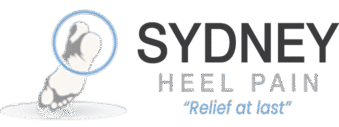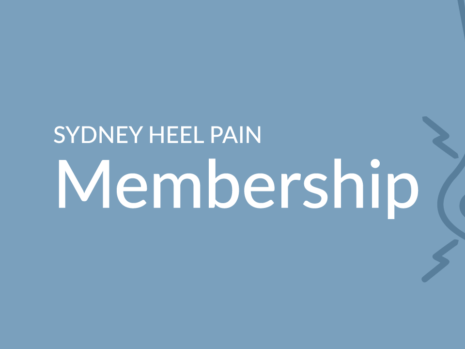Case Study 10 August 2016 : Achilles Tendonitis Causing Heel Pain
A 50-year-old male presents to the clinic complaining of posterior heel pain of more than 2 years. He is a keen golfer and plays 18 holes twice a week. His heel pain is bad in the mornings and hurts him after he has been sitting down for more than 30 minutes, particularly after a game of golf. He also describes pain in the Achilles Tendon in the same left foot. He has been playing golf for many years and never uses a cart, preferring to walk as part of the game and part of his exercise. He is slightly overweight and understands that this puts more pressure on his knees and feet.
This patient went to visit his doctor who examined the foot and informed the patient that he has Achilles Tendonitis, and subsequently arranged an X ray. The X ray report did in fact describe a posterior Heel Spur at the insertion of the Achilles Tendon.
Heel pain from Achilles Tendonitis is very common and is usually seen in patients who walk a lot but do not stretch. A limited range of motion occurs at the ankle joint due to stiffness in the Calf muscles and this in turn causes pulling through the Achilles Tendon. The Achilles Tendon usually becomes irritated if the pulling persist for long enough and then becomes inflamed. This inflammation in the Achilles Tendon sheath is commonly known as Achilles Tendonitis.
The over use of the Achilles Tendon also results in the formation of the Heel Spur – the constant pulling on the back of the heel bone results in the growth of the spur in the direction of pull.
However, the pain at the back of the heel is usually caused by a degeneration of the Achilles Tendon, at the site of the attachment to the heel bone itself. This condition is known as Achilles Tendinosis or Achilles Tendinopathy.
In summary, posterior heel pain can be caused by the Achilles Tendinosis / Tendinopathy and the pain in the Achilles Tendon is a result of the Achilles Tendonitis.
It is important to ensure that the pain is not being caused by retro calcaneal bursitis, and this can be determined by physical examination and ultra sound scan.
PHYSICAL EXAMINATION FOR ACHILLES TENDONITIS
There is visible thickening and redness of this patients left Achilles Tendon. It is hot to touch and overall looks larger than his healthy Achilles Tendon on the right foot. There is a jump response and pain reported with mild finger pressure – laterally. The patient reports extreme pain when the tendon is squeezed.
Lower down the leg, at the back of the heel bone and the site of the patient’s Heel Spur there is pain when pressure is applied into the heel.
The patient is informed that he does in fact have 2 conditions that are causing pain – Achilles Tendonitis and Achilles Tendinosis. The latter of these 2 is also known as an enthesopathy – which describes a disorder of a tendon attachment.
It is still unclear as to the cause of an enthesopathy although in the Achilles Tendon it seems to be related to the ageing foot. This suggests that circulation and blood flow plays a part as can general health and some medications.
ACHILLES TENDONITIS TREATMENT
This patient has a very big jump response and reports extreme pain on palpation of the tendon. He also reports hobbling and gait compensation, particularly later in the day. To this end, he was fitted with an immobilisation boot to unload the tendon and to allow it to settle. He was advised that he would probably be wearing the boot for 4 to 6 weeks. A 9mm heel wedge was inserted into the boot to elevate the heel and further unload the Achilles Tendon. The patient was asked to walk around the clinic for 5 minutes, which he did without heel pain. In addition to healing of the Achilles Tendon, the boot provides immediate pain relief and hence emotional relief too. When the foot hurts for more than 2 to 3 months on a day to day basis, patients become very frustrated and emotional, and need a psychological break from the pain. This patient felt that emotional relief and was quite overwhelmed. This is common.
ACHILLES TENDINOSIS TREATMENT
This patient was advised that by increasing blood flow to the back of the heel, the tendon attachment would have more chance of recovery. He agreed to receive treatment with the shock wave therapy unit and this was performed immediately during this initial consultation.
SHOCK WAVE THERAPY FOR ACHILLES TENDONITIS / TENDINOSIS
The probe was applied to the shaft of the Achilles Tendon at a frequency of 6 HZ and 1.8 Bar of pressure. 2000 reps were applied and were well tolerated. The tendon felt free and loose after the treatment and the pain was reduced during sitting and walking. The probe was then applied to the back of the heel and the pressure dropped to 1.0 Bar and a frequency of 5 HZ. 2000 reps were applied to the Heel Spur area around the back of the heel bone.
STRETCHING FOR ACHILLES TENDONITIS / TENDINOSIS
This patient had tight calf muscles due to lack of stretching and a lot of walking during golf. The tightness in the Gastroc and Soleus muscles puts strain on the Achilles Tendon and delays healing. The following stretches were demonstrated, explained and instructed.
FOOTWEAR CHANGES FOR ACHILLES TENDONITIS / ACHILLES TENDINOSIS
This patient brought several pairs of shoes to the appointment including golf shoes. It was found that his footwear did not suit his foot type, nor did it provide the correct type of support for the rehabilitation of his conditions. The patient was asked to walk on a treadmill in bare feet and a digital video was captured. This was replayed to the patient so the he could see how his feet functioned. He was then able to understand which type of shoes were more appropriate for him and his foot type.
FOLLOW UP
This patient was asked to return for weekly visits of shock wave therapy. After the 3rd treatment his heel pain had improved and there was a reduction in the Achilles Tendonitis. The Achilles tendon was “looser” and more “pliable” and was not as hot or as red as before.
The pain and stiffness that he experienced first thing in the morning was still present but was less. Pain after golf was also better.
Treatment continued for 6 weeks but the boot was removed after 4. Improvement was typical in that each week the heel pain was less and the symptoms in the Achilles Tendon had reduced. The patient was asked to continue stretching as part of his daily routine, especially when playing golf. He was advised to return to the clinic if his symptoms worsened.
Note: The symptomatic Achilles Tendon was still a little thicker and still tender to squeeze at the end of treatment. This is often the case and healing usually continues during the weeks that follow. Blood flow to the Achilles Tendon is poor and so healing can take several months.
More info:
Written by Karl Lockett





